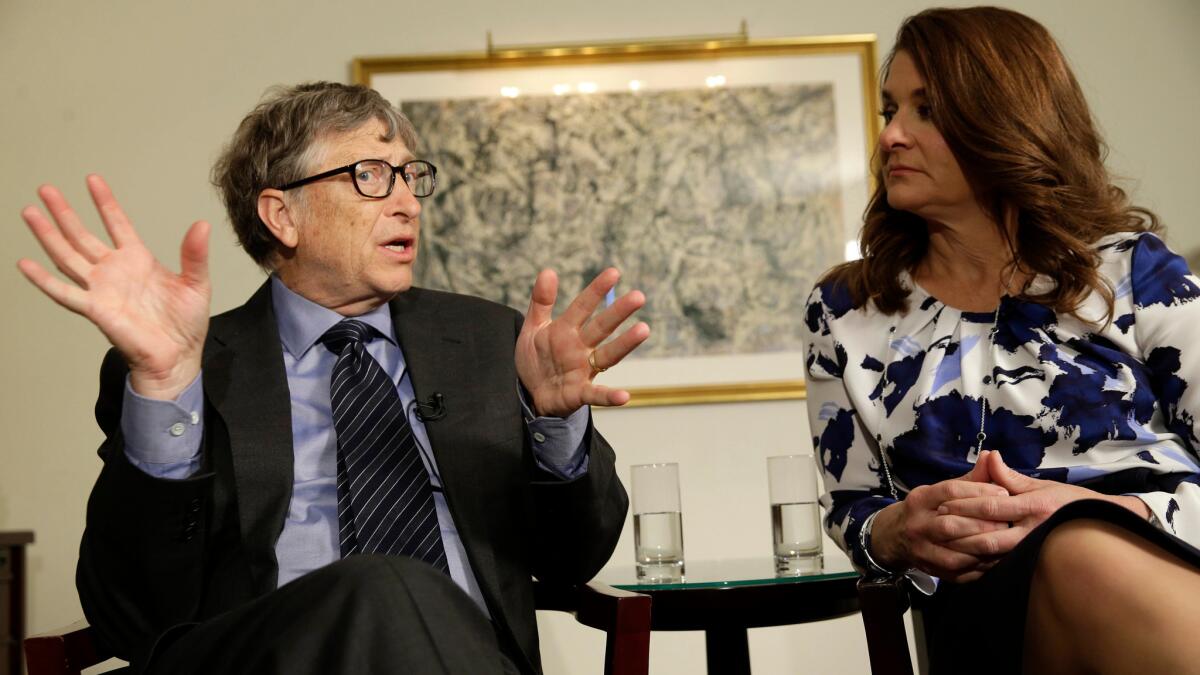Editorial: Gates Foundation failures show philanthropists shouldn’t be setting America’s public school agenda

- Share via
Tucked away in a letter from the Bill and Melinda Gates Foundation last week, along with proud notes about the foundation’s efforts to fight smoking and tropical diseases and its other accomplishments, was a section on education. Its tone was unmistakably chastened.
“We’re facing the fact that it is a real struggle to make systemwide change,” wrote the foundation’s CEO, Sue Desmond-Hellman. And a few lines later: “It is really tough to create more great public schools.”
The Gates Foundation’s first significant foray into education reform, in 1999, revolved around Bill Gates’ conviction that the big problem with high schools was their size. Students would be better off in smaller schools of no more than 500, he believed. The foundation funded the creation of smaller schools, until its own study found that the size of the school didn’t make much difference in student performance. When the foundation moved on, school districts were left with costlier-to-run small schools.
Then the foundation set its sights on improving teaching, specifically through evaluating and rewarding good teaching. But it was not always successful. In 2009, it pledged a gift of up to $100 million to the Hillsborough County, Fla., schools to fund bonuses for high-performing teachers, to revamp teacher evaluations and to fire the lowest-performing 5%. In return, the school district promised to match the funds. But, according to reports in the Tampa Bay Times, the Gates Foundation changed its mind about the value of bonuses and stopped short of giving the last $20 million; costs ballooned beyond expectations, the schools were left with too big a tab and the least-experienced teachers still ended up at low-income schools. The program, evaluation system and all, was dumped.
The Gates Foundation strongly supported the proposed Common Core curriculum standards, helping to bankroll not just their development, but the political effort to have them quickly adopted and implemented by states. Here, Desmond-Hellmann wrote in her May letter, the foundation also stumbled. The too-quick introduction of Common Core, and attempts in many states to hold schools and teachers immediately accountable for a very different form of teaching, led to a public backlash.
“Unfortunately, our foundation underestimated the level of resources and support required for our public education systems to be well-equipped to implement the standards,” Desmond-Hellmann wrote. “We missed an early opportunity to sufficiently engage educators — particularly teachers — but also parents and communities, so that the benefits of the standards could take flight from the beginning.
“This has been a challenging lesson for us to absorb, but we take it to heart. The mission of improving education in America is both vast and complicated, and the Gates Foundation doesn’t have all the answers.”
It was a remarkable admission for a foundation that had often acted as though it did have all the answers. Today, the Gates Foundation is clearly rethinking its bust-the-walls-down strategy on education — as it should. And so should the politicians and policymakers, from the federal level to the local, who have given the educational wishes of Bill and Melinda Gates and other well-meaning philanthropists and foundations too much sway in recent years over how schools are run.
That’s not to say wealthy reformers have nothing to offer public schools. They’ve funded some outstanding charter schools for low-income students. They’ve helped bring healthcare to schools. They’ve funded arts programs.
The Gates Foundation, according to Desmond-Hellmann’s letter, is now working more on providing Common Core-aligned materials to classrooms, including free digital content that could replace costly textbooks, and a website where teachers can review educational materials. That’s great: Financial support for Common Core isn’t a bad thing. When the standards are implemented well, which isn’t easy, they ought to develop better reading, writing and thinking skills.
And foundation money has often been used to fund experimental programs and pilot projects of the sort that regular school districts might not have the time or extra funds to put into place. Those can be extremely informative and even groundbreaking.
But the Gates Foundation has spent so much money — more than $3 billion since 1999 — that it took on an unhealthy amount of power in the setting of education policy. Former foundation staff members ended up in high positions in the U.S. Department of Education — and, in the case of John Deasy, at the head of the Los Angeles Unified School District. The foundation’s teacher-evaluation push led to an overemphasis on counting student test scores as a major portion of teachers’ performance ratings — even though Gates himself eventually warned against moving too hastily or carelessly in that direction. Now several of the states that quickly embraced that method of evaluating teachers are backing away from it.
Philanthropists are not generally education experts, and even if they hire scholars and experts, public officials shouldn’t be allowing them to set the policy agenda for the nation’s public schools. The Gates experience teaches once again that educational silver bullets are in short supply and that some educational trends live only a little longer than mayflies.
Follow the Opinion section on Twitter @latimesopinion and Facebook
MORE FROM OPINION
We get the candidates our undignified media deserve
Russia’s got a point: The U.S. broke a NATO promise
More to Read
A cure for the common opinion
Get thought-provoking perspectives with our weekly newsletter.
You may occasionally receive promotional content from the Los Angeles Times.










